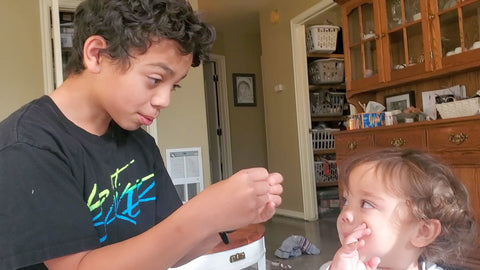Before We Begin
Please understand that you should not “TEACH” baby sign language to your infant. What is preferred is that you “MODEL” the signs in context so that your baby can see the signs and associate those gestures with what is happening around them.
You can support the signs with your voice saying the word along with the sign, but you should not try to TEACH your baby anything at this early stage of development. The best process is for your child to see the signs, attach the sign to what is happening, and then draw on their own internal resources to figure out what is going on and respond with communication.
That process not only allows your child to “discover” their abilities to engage and affect their environment, but it also offers an opportunity for your child to develop confidence in their ability to ask for and receive care. This is a common baby sign language challenge–to keep the signs in context, using basic baby signs at first and adding signs as your activities increase.
The benefits that come from this early communication are many. The best Step-by-Step guide for learning signs and having them ready to MODEL to your child is the Baby Sign Language in 14 Days program. It demonstrates how to teach baby signs, when to do it, techniques for modeling signs and which signs are best to start with and which signs to add on and when to add them.

Baby Signing Reduces Frustration and Tantrums
A baby’s unfulfilled expectations can result in frustration. No matter how good a parent you are, you will never anticipate your baby’s every need. The reactionary behavior displayed during the “Terrible Twos” is partly a result of his frustration.
Much of your baby's frustration may come from restricted communication and being unable to get what they want through their communication. From the time that your baby recognizes that they want something to the time it takes for you to understand the need can be a long, frustrating time. However, frustration levels drop dramatically when your baby signs. Using signs, they are able to convey their needs swiftly and calmly, replacing frustration with communication.
Nothing sets off an infant quicker than the parent saying “no” to something the baby wants, without receiving a reason, explanation, or possible alternative from the parent. Signing with your baby assists you in providing an alternative to the word “no.”
For example, if my children wanted juice or a sweet snack before dinner, I would say/sign, “When you have FINISHED EATING.” Or, if they wanted to watch a movie before bath time, I would say/sign, “Yes, you can watch the movie when you have FINISHED having a BATH.”

Their request was acknowledged each time, but it was clear that they had to do something first to have their request fulfilled. I found that with time there were fewer tantrums and confrontations.
Parents and caregivers can often eliminate frustration and the resulting crying fits with simple communication. I appreciate that intuitive parents can sometimes read their baby’s cries without resorting to gestures. Yet, you may not always be right, and signing offers you a more accurate system for finding out what your baby wants or needs.
Signs minimize the guesswork and so, in turn, frees up time for more positive interactions with the child. There is something wonderful about witnessing a signing family communicating together in a warm, easy, and natural way.
It is not only immediate family members who get the benefit of reduced frustration levels. Sign language is becoming more and more a standard part of preschool curricula because it minimizes stress for children and for professional caregivers who must respond to the needs of several children at a time.
Childcare staff members have reported lower noise intensities when infants use signing rather than resorting to deafening screams or crying. They also say that signing significantly reduces incidences of behavior such as tantrums, hitting and biting.
Through signs, infants learn concepts like being GENTLE and SHARING at an early age and begin to understand kindness and cooperation. Young children can also use signs such as STOP or STAY AWAY as a strategy to protect themselves from other young children.
Baby Signing Strengthens the Bond Between You and Your Baby
Obviously, where you have open lines of communication between people, you create deeper relationships. It is only natural, therefore, that when your baby can share their thoughts, feelings, desires, and observations with you, your relationship with them is transformed.
Your babies will quickly learn that using sign language achieves far more than they achieves crying. Using signs helps you meet their needs more effectively, and it will delight you when they describe something that interests them. Children will be overjoyed when they initiate conversations—and you and other caregivers will be attentive when they are able to express specific thoughts and feelings.
Understandably, being with babies is more fun and rewarding when you can communicate with them. Interacting through sign lessens the number of stressful exchanges and increases the opportunity for constructive ones, resulting in more quality time. With language comes a stronger bond between you and your baby.
As signs take hold, your child will also begin to look to you for information about the world. They learn that they can rely on you to give them that information—in a format that they can use. But this stronger bond is not restricted to the relationship between you and your child. Closer ties are also formed with siblings, the extended family, and those outside the immediate family, such as friends and professional caregivers.
When babies learn to communicate, they become active and integral community members, rather than passive observers until they have learned to articulate words.
Big brother showing his little brother how to sign MORE


